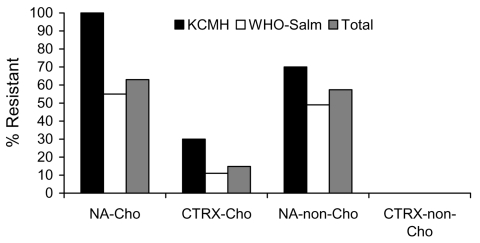To the Editor: Despite improved public health, serious infections with nontyphoidal Salmonella enterica remain a major clinical and public health concern in Thailand and worldwide (1,2). Life-threatening Salmonella infections resistant to fluoroquinolones, extended-spectrum cephalosporins, or both, have been increasingly reported (3). Use of antimicrobial drugs for disease prevention and growth promotion in food animals has been implicated in this increase in drug resistance (4). Because of extensive global travel, such increases affect the medical community domestically and internationally (5). We report a pilot survey of drug resistance in Salmonella spp. in Thailand.
We studied archival nontyphoidal Salmonella isolates from bacteremic patients at King Chulalongkorn Memorial Hospital from January 2003 to October 2005 and from bacteremic patients in Thailand sent to the World Health Organization National Salmonella and Shigella Center in Bangkok during the first half of 2005. The isolates from these archives were nonoverlapping and were kept frozen at −80°C. Isolates were divided into Salmonella serovar Choleraesuis and other nontyphoidal Salmonella (non-Choleraesuis) because we observed that Choleraesuis isolates show a higher frequency of resistance to fluoroquinolones and extended-spectrum cephalosporins than non-Choleraesuis isolates. A standard Etest method (AB Biodisk, Solna, Sweden) was used to evaluate MICs for nalidixic acid, ciprofloxacin, and ceftriaxone. Susceptibility was defined according to the 2005 criteria for Salmonella of the Clinical Laboratory Standards Institute (CLSI, formerly NCCLS) (6).
Isolates showed high frequencies of antimicrobial drug resistance (Figure). All S. Choleraesuis isolates with ceftriaxone resistance also showed high levels of resistance to nalidixic acid (MIC ≥256 µg/mL); most of these also had reduced susceptibility to ciprofloxacin (MIC ≥0.125 µg/mL). Of 73 nalidixic acid–resistant Salmonella isolates, 55 (75%) required a ciprofloxacin MIC ≥0.125 µg/mL, 14 (19%) required an MIC of 0.094 µg/mL, and 4 (6%) required an MIC of 0.064 µg/mL. One patient with aortitis caused by ceftriaxone-resistant S. Choleraesuis died of a ruptured mycotic aneurysm.
Figure.
Percentage of nontyphoidal Salmonella isolates resistant to nalidixic acid (NA) and ceftriaxone (CTRX), Thailand. KCMH, King Chulalongkorn Memorial Hospital; WHO-Salm, World Health Organization Salmonella and Shigella Center. Cho, Choleraesuis; non-Cho, non-Choleraesuis. The analysis included 10 Cho isolates from KCMH, 44 Cho isolates from WHO-Salm, 27 non-Cho isolates from KCMH, and 41 non-Cho isolates from WHO-Salm. Two Cho isolates from WHO-SAlm with intermediate MICs for ceftriaxone are also included.
In the food animal industry, the effect of using antimicrobial drugs has long been a subject of concern (7–9). Evidence from molecular epidemiologic studies (9) suggests that these concerns are genuine and that serious problems must be addressed. This concern is also supported by reports of fatal, invasive, nontyphoidal Salmonella infections resistant to quinolones or extended-spectrum cephalosporins (7,10). In Thailand, enrofloxacin, a veterinary fluoroquinolone, is used in animals in the poultry, swine, and seafood industries. Ceftiofur, a third-generation cephalosporin, is used extensively in swine for treatment and prevention of disease and for growth promotion. When compared with previous susceptibility patterns (5), current nontyphoidal Salmonella infections in humans in Thailand are more resistant to quinolones and cephalosporins. Susceptibility to nalidixic acid correlates well with reduced susceptibility to ciprofloxacin. An alarming increase in ceftriaxone resistance in S. Choleraesuis may be associated with inappropriate cephalosporin use in swine farming. Major revisions in current policies for use of antimicrobial drugs in food animals in Thailand are warranted.
Acknowledgments
This study was supported by a research grant from the National Research Council of Thailand through Chulalongkorn University, Ratchadapiseksompotch Fund from the Faculty of Medicine, Chulalongkorm University, and a development grant for new faculty/researchers, Chulalongkorn University. W.K. was supported by the Faculty Fund, Faculty of Medicine and Research Scholar Fund, Thailand Research Fund.
Footnotes
Suggested citation for this article: Kulwichit W, Chatsuwan T, Unhasuta C, Pulsrikarn C, Bangtrakulnonth A, Chongthaleong A. Drug-resistant nontyphoidal Salmonella bacteremia, Thailand [letter]. Emerg Infect Dis [serial on the Internet]. 2007 Mar [date cited]. Available from http://www.cdc.gov/eid/content/13/3/501.htm
Presented at the 16th European Congress of Clinical Microbiology and Infectious Diseases, April 1–4, 2006, Nice, France.
References
- 1.Aarestrup FM, Lertworapreecha M, Evans MC, Bangtrakulnonth A, Chalermchaikit T, Hendriksen RS, et al. Antimicrobial susceptibility and occurrence of resistance genes among Salmonella enterica serovar Weltevreden from different countries. J Antimicrob Chemother. 2003;52:715–8. 10.1093/jac/dkg426 [DOI] [PubMed] [Google Scholar]
- 2.Bangtrakulnonth A, Pornreongwong S, Pulsrikarn C, Sawanpanyalert P, Hendriksen RS, Lo Fo Wong DM, et al. Salmonella serovars from humans and other sources in Thailand, 1993–2002. Emerg Infect Dis. 2004;10:131–6. [DOI] [PMC free article] [PubMed] [Google Scholar]
- 3.Sun HY, Tseng SP, Hsueh PR, Hung CC, Hsieh SM, Teng LJ, et al. Occurrence of ceftriaxone resistance in ciprofloxacin-resistant Salmonella enterica serotype Choleraesuis isolates causing recurrent infection. Clin Infect Dis. 2005;40:208–9. 10.1086/426695 [DOI] [PubMed] [Google Scholar]
- 4.Hsueh PR, Teng LJ, Tseng SP, Chang CF, Wan JH, Yan JJ, et al. Ciprofloxacin-resistant Salmonella enterica Typhimurium and Choleraesuis from pigs to humans, Taiwan. Emerg Infect Dis. 2004;10:60–8. [DOI] [PMC free article] [PubMed] [Google Scholar]
- 5.Hakanen A, Kotilainen P, Huovinen P, Helenius H, Siitonen A. Reduced fluoroquinolone susceptibility in Salmonella enterica serotypes in travelers returning from Southeast Asia. Emerg Infect Dis. 2001;7:996–1003. [DOI] [PMC free article] [PubMed] [Google Scholar]
- 6.Clinical and Laboratory Standards Institute (CLSI). Performance standards for antimicrobial susceptibility testing; 15th informational supplement. CLSI/NCCLS M100-S15. Wayne (PA): The Institute; 2005.
- 7.Helms M, Simonsen J, Molbak K. Quinolone resistance is associated with increased risk of invasive illness or death during infection with Salmonella serotype Typhimurium. J Infect Dis. 2004;190:1652–4. 10.1086/424570 [DOI] [PubMed] [Google Scholar]
- 8.Phillips I, Casewell M, Cox T, de Groot B, Friis C, Jones R, et al. Does the use of antibiotics in food animals pose a risk to human health? A critical review of published data. J Antimicrob Chemother. 2004;53:28–52. 10.1093/jac/dkg483 [DOI] [PubMed] [Google Scholar]
- 9.Su LH, Chiu CH, Chu C, Ou JT. Antimicrobial resistance in nontyphoid Salmonella serotypes: a global challenge. Clin Infect Dis. 2004;39:546–51. 10.1086/422726 [DOI] [PubMed] [Google Scholar]
- 10.Helms M, Vastrup P, Gerner-Smidt P, Molbak K. Excess mortality associated with antimicrobial drug–resistant Salmonella typhimurium. Emerg Infect Dis. 2002;8:490–5. [DOI] [PMC free article] [PubMed] [Google Scholar]



